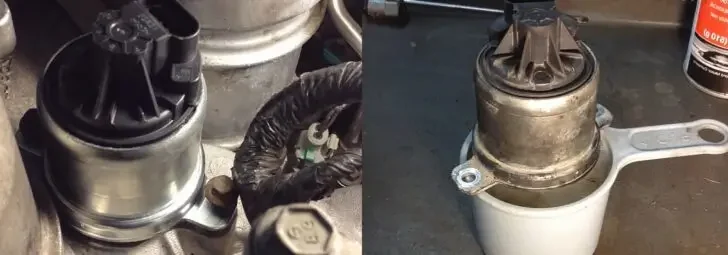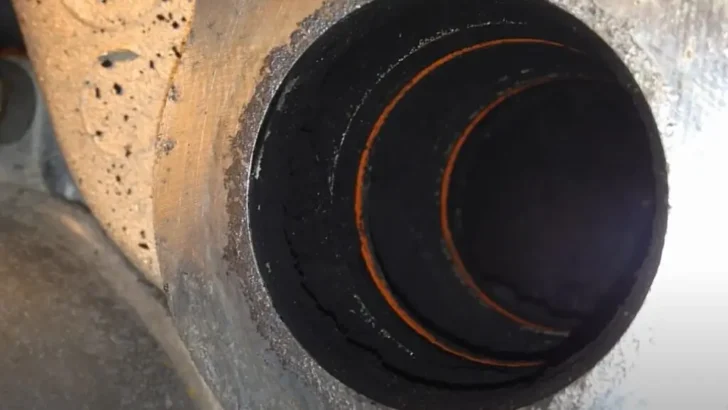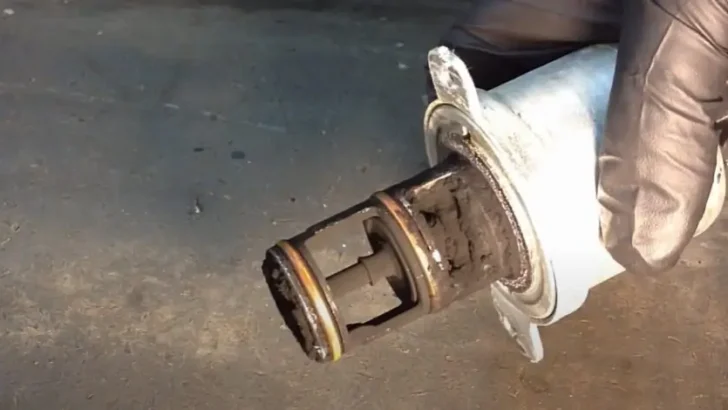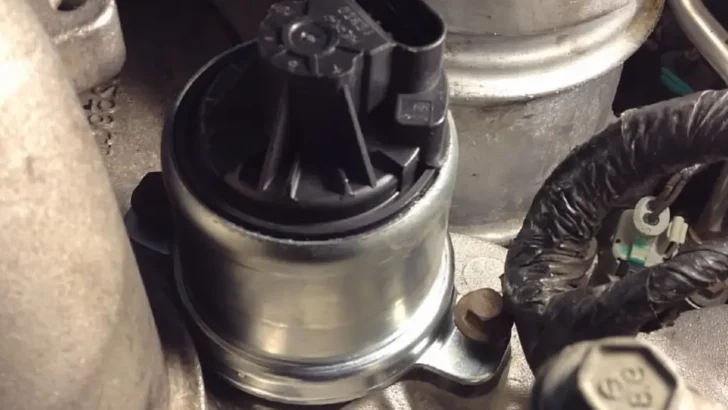If you are a proud 6.0 Powerstroke owner, you might see the P0401, P0402, and P0404 codes more often than other car owners. This is why many Ford owners ask why does the EGR valve get carbon buildup on the 6.0 so often.
In this blog post, I am going to talk about why does the EGR valve get carbon buildup on a 6.0 and how to clean the EGR valve.
Key Takeaway
- The EGR valve on a 6.0 gets carbon buildup if you drive the vehicle in short distances without allowing the engine temperature to reach its optimal level. This leads to incomplete combustion and as a byproduct, there is carbon that gets buildup on the EGR valve.
- The EGR valve on a 6.0 gets carbon buildup because it reintroduces a portion of exhaust gas back into the intake manifold, leading to increased soot and carbon, particularly in environments with high wear and tear.
Why Does EGR Valve Get Carbon Buildup On a 6.0

The EGR valve on a 6.0 gets carbon buildup due to its function of recirculating exhaust gases back into the combustion chamber, which often contains nitrous and other residues leading to carbon deposits.
Earlier, most people used their vehicles only for short distances which did not give the engine enough time to reach its optimum operating temperature.
This led to incomplete combustion of the fuel which in turn resulted in soot (unburned carbon) being deposited on the EGR valve and other engine parts.
The EGR valve takes exhaust gasses that are high in nitrous oxides and sucks them back into the engine. It actually cools the combustion chamber and allows the engine to run better.
Another reason for carbon buildup on a 6.0 is the use of low-quality fuels. These fuels have a higher carbon content and do not burn completely, leaving behind a residue that gets deposited on the EGR valve.
The incorrect timing of the EGR system can also be a reason why the EGR valve gets carbon buildup. If the EGR system opens too early, before the engine has reached its optimum operating temperature, it can lead to incomplete combustion and carbon buildup.
Similarly, if it opens too late after the engine has reached its maximum temperature, it can lead to overheating and damage to the engine.
The presence of oil in the exhaust gas can also lead to carbon buildup in the EGR valve. This can happen due to two reasons; either due to an oil leak in the engine or due to incorrect valve clearance. Oil in the exhaust gas will coat the EGR valve and other engine parts, leading to carbon buildup.
How To Clean an EGR Valve on a 6.0

- Open the hood and locate the EGR valve. It is near the firewall.
- Remove the wiring harness and the two bolts that hold it in place.
- Clean the inside of the EGR port.
- Remove the O-rings and the gasket from the EGR valve
- Remove the large carbon deposits from the EGR valve
- Soak the EGR valve in the liquid cleaner. Make sure that the electrical connector doesn’t get wet.
- Install the new o-rings and gasket.
- Reinstall the EGR valve.
Cleaning the EGR valve on a 6.0 or any other vehicle is much cheaper than actually replacing the EGR valve every time it gets clogged by carbon. So, each time you get a P0401, P0402, and P0404 trouble code, first clean the EGR valve and see if that fixes the issue. Here is how to clean an EGR valve on a 6.0.
1. Required tools for the task
- Wire brush (view on amazon.com)
- Liquid EGR valve cleaner (view on amazon.com)
- EGR valve o-ring kit (view on amazon.com)
2. Open the hood and locate the EGR valve
With the engine cooled down, open the hood and locate the EGR valve. The EGR valve on a 6.0 is located behind the air intake elbow, between the alternator and the oil filter housing. It has a round shape and is equipped with an electrical connector on top of it.
3. Remove the EGR valve

First, disconnect the electrical connection and set it aside. The EGR valve is secured by two bolts which can be removed with a 5/16” and an extension.
Safely store the two bolts for later. If you are clumsy like me, loosen the bolts almost to the end and then grab them with pliers. In order to remove the EGR valve, you need to pull it straight upwards. Depending on how bad the carbon build-up is, you might have to wiggle it a little bit.
4. Clean the EGR port

Cleaning the port inside the actual intake where the EGR valve sits is as important as cleaning the EGR valve itself. This is where all of the EGR flow comes from. If your EGR valve has carbon build-up, there is a great chance that the port itself has carbon build-up too.
If you leave the port dirty, all of the carbon build-ups will simply end up in the cleaned EGR valve and will cause it to fail soon.
So, grab a spatula or something that is not too pointy and scrape the walls of the port. Try to get as many deposits as you can. As you scrape them, the deposits will fall down the port but do not worry. After you are done scraping, you will vacuum them. Make sure you get all of the deposits or else you will have a crank-no start upon completion of this repair.
5. Remove the O-rings and the gasket from the EGR valve

The EGR valve has two o-rings and a gasket that seals the EGR valve to the intake manifold. It is always a good idea to remove the old ones. They are probably going to be dry-rotted from all of the carbon. So, grab a screwdriver and remove the two o-rings and the gasket.
6. Remove the large carbon deposits from the EGR valve

The carbon build-up on the EGR valve causes it to trigger P0401, P0402, and P0404 trouble codes because it is unable to come back to the home position or get stuck and not be able to open all the way. Either way, carbon is the issue.
Make sure that you are wearing gloves because these carbon deposits will stain your hands for a week. First, start by removing any loose chalky carbon with a screwdriver. Be careful not to damage any of the components. Next, grab a wire brush and try to clean any left carbon deposits before spraying it with a carbon cleaner.
7. Soak the EGR valve into the liquid cleaner

There are a lot of EGR valve cleaners on the market. They can either be spray or liquid. I always get the liquid one because I like to soak in the EGR valve that way it can get cleaned really well. What works for me, and will work for you too, is a kitchen measuring cup.
The reason why the measuring cup is perfect is that we don’t want to soak in the EGR valve completely. There are ports that we exposed when removing the gasket which shouldn’t be sprayed or submerged as well as the electronics on top of the EGR valve.
So, fill the kitchen measuring cup with the liquid carbon cleaner and put the EGR valve in it. The little ears on the EGR valve will hold it exactly where it should and won’t allow for the ports to get wet. Leave it to soak for at least half an hour and it will dissolve all of the remaining carbon build-ups.
Depending on how badly your EGR valve is clogged, you can remove it from the cleaning solution brush it with a wire brush, and then let it sit again. When done, wipe the EGR valve with a clean towel and let it dry for about thirty minutes.
8. Install the new o-rings and gasket

After the EGR valve is cleaned and completely dry, you need to install the two o-rings and one gasket. The new o-rings are made from rubber and are pretty flexible, so getting them on the EGR valve is pretty easy. The same goes for the gasket that sits on top.
9. Reinstall the cleaned EGR valve

With the new o-rings and gasket installed, it is time to reinstall the EGR valve. Place it back into the port and line up the holes so you can insert the bolts. Tighten them down evenly on both sides, little by little. The spec on the EGR valve bolts is 120-inch pounds. Then, reconnect the electrical connector and make sure it snaps all the way in.
Symptoms of Carbon Buildup on The EGR Valve
- Reduced engine performance and power
- Poor fuel economy
- Difficulty starting the engine
- Rough idle or stalling
- Check engine light comes on
- Increased emissions and failed emissions test
- Pinging or knocking noise from the engine
FAQs
Q: How can I prevent carbon buildup on the EGR valve?
A: To prevent carbon buildup on the EGR valve, regular maintenance is essential. This includes performing routine engine tune-ups, using high-quality fuel and lubricants, and ensuring proper airflow through the intake and exhaust systems. It is also recommended to periodically clean the EGR valve to remove any carbon deposits.
Q: Can I clean the EGR valve myself?
A: Yes, it is possible to clean the EGR valve yourself. However, it requires some mechanical knowledge and the right tools. It involves removing the valve, inspecting it for any damages, using a carbon cleaning solvent to dissolve the buildup, and re-installing it properly. It’s important to follow the manufacturer’s guidelines and safety precautions when attempting to clean the EGR valve.
Q: When should I clean or replace the EGR valve?
A: The frequency of cleaning or replacing the EGR valve depends on several factors, such as the vehicle’s mileage, maintenance history, and driving conditions. It is recommended to refer to the vehicle’s owner manual or consult with a professional mechanic to determine the appropriate intervals for cleaning or replacing the EGR valve.
Q: How much does it cost to replace an EGR valve?
A: The cost of replacing an EGR valve can vary depending on factors such as the vehicle make and model, the brand of the replacement valve, and labor costs. On average, you can expect to spend anywhere from $200 to $500 for the parts and installation of a new EGR valve.
Q: Can carbon buildup on the EGR valve affect fuel economy?
A: Yes, carbon buildup on the EGR valve can negatively impact fuel economy. When the valve is clogged or not functioning properly due to carbon deposits, it can cause an imbalance in the air-to-fuel ratio and lead to inefficient combustion. This inefficiency can result in increased fuel consumption and decreased fuel economy.
Q: Are there any aftermarket solutions to prevent carbon buildup on the EGR valve?
A: Yes, there are aftermarket solutions available that claim to prevent carbon buildup on the EGR valve. These include additives that are added to the fuel or oil, which claim to clean the valve and prevent future deposits. However, it is important to do thorough research and consult with professionals before using any aftermarket products to ensure their effectiveness and compatibility with your specific vehicle.
Q: Can carbon buildup on the EGR valve cause engine damage?
A: Carbon buildup on the EGR valve itself may not directly cause significant engine damage. However, if left untreated, it can lead to other issues such as restricted airflow, decreased engine performance, and increased emissions. These problems can potentially cause damage to other engine components over time if not addressed promptly.
Q: Is carbon buildup on the EGR valve a common issue on 6.0 engines?
A: Yes, carbon buildup on the EGR valve is a common issue that many owners of 6.0 engines encounter. The design of the EGR system, combined with certain operating conditions and factors such as fuel quality, can contribute to the formation of carbon deposits. Regular maintenance and addressing the issue promptly can help mitigate the effects of carbon buildup on the EGR valve.
In Conclusion
Carbon buildup on a 6.0 turbo diesel engine occurs due to the combustion process, which produces soot particles that can adhere to the EGR valve and cause it to become clogged up over time.
This can lead to decreased power output, increased fuel consumption, and more frequent service intervals due to the need for more frequent EGR valve cleaning and maintenance.
